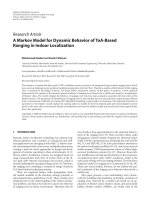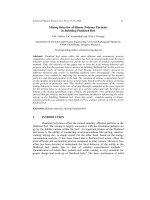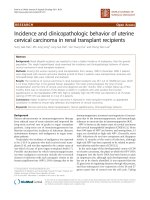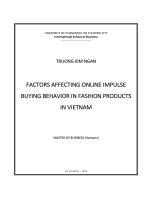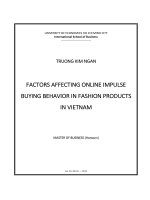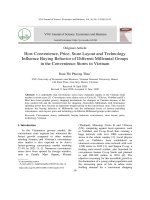Impulse buying behavior of generation Z customers in social commerce: Flow theory approach
Bạn đang xem bản rút gọn của tài liệu. Xem và tải ngay bản đầy đủ của tài liệu tại đây (210.18 KB, 12 trang )
<span class="text_page_counter">Trang 1</span><div class="page_container" data-page="1">
<b> Impulse Buying Behavior of Generation Z customers in Social Commerce: Flow Theory Approach </b>
Canh Chi Hoang
<sup>1</sup>, Bui Thanh Khoa
<sup>2+</sup><small>1</small>University of Finance – Marketing, Vietnam<small>2</small>Industrial University of Ho Chi Minh City, Vietnam
<i>, <sup>+</sup> (Corresponding author) </i>
<b>Abstract.</b>
<small> In social commerce, Generation Z (Gen Z) customers have different motivations to create a flow state that leads to impulse buying behavior. To better understand what motivates Gen Z customers to make impulse purchases in social commerce, this study established a theoretical framework on the antecedents of flow experience and the relationship between flow experience and impulse buying behavior. Based on the research model, the Partial Least Squares Structural model was used to empirically evaluate data from 283 consumers with the previous social media purchase experience. According to the data, the antecedent factors all significantly affect the flow experience, and the flow experience strongly influences impulse buying behavior. Based on the research results, this study proposed some managerial implications for merchants on social networking sites to increase Gen Z’s flow experience and impulsive buying behavior. </small><b>Keywords:</b>
<small> flow experience, impulse buying behavior, Gen Z, social commerce </small>Vol. 9 (2022) No.4, pp.197-208 DOI:10.33168/LISS.2022.0413
</div><span class="text_page_counter">Trang 2</span><div class="page_container" data-page="2"><b>1. Introduction </b>
<i>Purchasing on the spur of the moment is known as impulse purchasing (Zihao et al., </i>
2022). Authors in the field of marketing research have spent much time trying to determine what aspects are most important when it comes to making a sale (Tinne, 2010). Online retail has exploded in popularity with the expansion of the Internet and the rise of electronic commerce. About 40% of all purchases made online are
<i>considered to be made on the spur of the moment (Liu et al., 2013). The liberated </i>
nature of internet shopping has led to a rise in impulse purchases compared to conventional purchasing, liberating shoppers from the limitations of in-store purchases made during normal work or home days.
Often referred to as "digitally aware," Generation Z (Gen Z) was the first to grow
<i>up in an entirely digital environment (Reinikainen et al., 2020). This new generation, </i>
which includes those born between 1995 and the early 2010s and which accounts for
<i>around 32% of the world's population (Priporas et al., 2020), is predicted to have a </i>
major influence on international sales. Gen Z customers are likelier to see online and social media ads (Vițelar, 2019). This generation is materialistic, has the highest expectations for speedy service, and values businesses' capacity to interact with them through social media. Specifically via famous people because they see them as more trustworthy (Wolf, 2020). Because of these factors, research on millennials' propensity for impulsive purchases promises to provide significant theoretical and applied insights
Developed by psychologist Csikszentmihalyi in 1990, "flow" describes how one feels when completely absorbed in what one is doing. As the argument goes, when someone is fully committed to completing a strenuous activity, they may lose track
<i>of time or their sense of identity (Khoa & Huynh, 2022; Mahnke et al., 2015). </i>
According to the principle of "flow," a person is most happy and productive when using their abilities to their fullest extent while also being challenged. Consequently, the individual might enter a peak mental state known as "flow," which promotes deep immersion and boosts cognition and happiness. When the difficulty of the work and the person's proficiency are both great, the person feels confident in their ability to do it and has a good time. Flow theory focuses on positive feedback loops, a branch of psychology that seeks to explain why certain people cannot stop engaging in seemingly meaningless activities.
Based on cognitive-emotional theory, the study developed a model and revealed beliefs about functional convenience and pleasure associated with online purchases. The study results show significant influences on the online store’s attractiveness, enjoyment of goods, and communication style, based on consumers’ emotions. Furthermore, Mustafi and Hosain (2020) showed that independent factors such as informativeness, arousal, entertainment, incentive, and credibility have a significant direct and indirect positive influence on intention online purchases through
</div><span class="text_page_counter">Trang 3</span><div class="page_container" data-page="3">a mediating effect on online shopping intention.
Researchers have conducted studies on impulse buying in traditional and online contexts. However, studying online impulse buying behavior in the social commerce of Gen Z, which will account for most of the market, especially the research based on the flow theory, still needs to be improved in Vietnam and the world. Therefore, this study was conducted to identify and measure the influence of influencing factors on the flow experience, forming the impulse buying behavior of Gen Z consumers on social commerce.
<b>2. Literature Review 2.1. Impulse buying behavior </b>
If a customer makes a purchase the moment he sees it, it is considered an impulse purchase. Emotional arousal, lack of self-control, and impulsive action, when exposed to a desired object or service are characteristics of this phenomenon. The rise of online retail further emphasizes the impulse buying phenomenon. Customers can easily make impulsive decisions when shopping online due to low barriers to entry,
<i>convenient procedures, and no social influence (Ek Styvén et al., 2017). Online stores </i>
are also likely to use more rational methods of product promotion to influence their customers; therefore, it can be asserted that Internet shopping has broadened the
<i>scope of impulse purchases (L. Wu et al., 2020). </i>
<b>2.2. Flow experience </b>
Humans experience a sense of unity known as “flow” whenever they respond to external stimuli with full participation and focus on the task at hand (Csikszentmihalyi, 1997). People who achieve this level of mental happiness are so absorbed in pursuing their favorite goals that they are not aware of any changes in their environment (Csikszentmihalyi & LeFevre, 1989). Flow experience has emerged as an essential consideration to enhance the online shopping experience in recent years. A customer’s perception of a particular shopping site’s traffic can
<i>significantly impact whether or not they purchase while exploring (L. Wu et al., 2020). </i>
Consumers are more susceptible to external cues during exploratory searching,
<i>which can lead to impulse purchases (Zhang et al., 2018). Those investigations all </i>
point to a possible link between flow state and impromptu online purchases. Indeed, the flow state has been implicated as a shopper’s emotional perspective when
<i>considering a spontaneous online purchase (L. Wu et al., 2020). Therefore, the study </i>
proposes hypothesis H1:
<i>H1. Flow experience will positively influence impulse buying behavior </i>
<b>2.3. The antecedence of flow experience </b>
Hung and Khoa (2022) pointed out that consumer satisfaction and buying propensity are influenced by their perception of the site’s interest and flow. Importantly, Service
</div><span class="text_page_counter">Trang 4</span><div class="page_container" data-page="4">quality affects consumers’ happiness and desire to purchase more than information and system quality. In addition, Gao and Bai (2014) showed that informativeness, efficiency, and entertainment influence customers’ flow experience when they choose Chinese online travel agency websites. Informality is also mentioned as a
<i>factor affecting flow experience in other studies (Wibowo et al., 2020). One of the </i>
most widely acknowledged variables in the study of flow is the need for a person to concentrate on their immediate surroundings to feel flow (Patanasiri & Krairit, 2018). Users' perception of risk during website exploration is critical for achieving a flow
<i>state and completing an online purchase, as confirmed by Morales-Solana et al. (2019). A new basis for flow experience was discovered by Martins et al. (2019): </i>
online advertising value, which is a consumer's subjective evaluation of the worth or usefulness of advertising. An individual's level of interest and happiness with the web as a medium and the information on the web are all crucial factors in determining whether or not a user will have a flow experience, and the sensation of pleasure is
<i>cited as a vital antecedent in a flow experience (Barta et al., 2021). Therefore, this </i>
study uses six premises for the purchasing experience of Gen Z customers when buying from social networking sites, including concentration, website/app quality, perceived risk, informativeness, enjoyment, and online advertising value.
<i>According to Hsu et al. (2012), the focus will attract users’ attention when using </i>
an online shopping platform. Measurements focus on how attentive consumers are
<i>when considering a particular buying situation. According to Morales-Solana et al. </i>
(2019), focus and personalization are the direct precursors of flow in online activity. So, the hypothesis put forward is:
<i>H2: Concentration has a positive effect on the flow experience </i>
<i>The website quality impacts consumer satisfaction and buying intent (Ajitha et </i>
<i>al., 2022; Hsu et al., 2012). The research aimed to model and investigated the role of </i>
perceived playfulness and perceived flow as mediators between website quality and user experience. It also assessed the link between these two factors using the context
<i>of an online travel agency (Fan et al., 2013). According to the findings of this study, </i>
the perceived flow and sense of playfulness of a website significantly impact the satisfaction of its visitors. This led researchers in the study to postulate:
<i>H3: Website/app quality has a positive effect on the flow experience </i>
According to Chen and Yao (2018), perceived risk in online shopping is determined by four causes: Supplier, consumer, technology, and product. These issues make the buyer feel hurt or lost, thus hindering the flow of experience and
<i>purchase intention. In addition, according to Morales-Solana et al. (2019), the lower </i>
the perceived risk, the greater the flow experience; in other words, the perceived risk harms the flow experience. So, the hypothesis put forward is:
<i>H4: Perceived risk has a negative effect on the flow experience </i>
</div><span class="text_page_counter">Trang 5</span><div class="page_container" data-page="5">Mustafi and Hosain (2020) studied the online smartphone purchase intention of customers in Bangladesh. Five independent variables, including informativeness, stimulation, entertainment, incentive, and reliability, impact customers’ purchase intention through two mediating variables, flow experience and advertising value. Therefore, hypothesis H5 posits that:
<i>H5: Informativeness has a positive effect on the flow of experience </i>
Users go online for various reasons, including acquiring knowledge and doing practical chores, but for pure recreation and fun (Guo & Poole, 2009). Users can completely lose themselves in their activities because of the positive vibes and entertaining surroundings they discover. Therefore, a feeling of flow correlates favorably with liking online buying. Moreover, several studies on customer behavior in e-commerce have shown that flow would rise when the perceived hedonic value is large, as flow theory suggests. Therefore, the study expects that shopping preferences will create a flow experience. Thus, hypothesis H6 is formulated as follows:
<i>H6: Enjoyment has a positive effect on the flow of experience </i>
With their attention fully focused on the signals they are receiving, free of any distractions, customers are more likely to have a greater sense of flow (Hoffman & Novak, 1996). Moreover, people give messages a positive rating if they are relevant
<i>to their requirements or include helpful shopping advice (Martins et al., 2019). Thus, </i>
the study proposes hypothesis H7:
<i>H7: Online advertising value has a positive effect on the flow experience </i>
The study proposes a theoretical model, as shown in Figure 1.
<small>Fig. 1: Theoretical model </small>
<b>3. Research method </b>
This study carried out qualitative research with a theoretical system of impulse buying behavior, as well as interviews with five experts in the field of marketing and e-commerce working at universities and online shopping sites goods online. Interviews
</div><span class="text_page_counter">Trang 6</span><div class="page_container" data-page="6">will take place in the form of in-depth interviews with experts. The researcher designed the discussion board and sent it to the members before the interview. The interviews involved exploring the perception of consumers’ experiences when making purchases on social networking platforms. The researchers adjusted the scale and built a quantitative research questionnaire. Finally, the author’s team selected samples in qualitative research according to the non-probability, purposeful method. Quantitative research will be carried out by collecting data through a prepared questionnaire survey. Data is collected from 283 customers who often shop on social networking platforms such as Facebook, Tiktok, and Zalo. Information about the research sample is shown in Table 1.
<small>Table 1: Demographic Information </small>
The scales in the study are inherited from previous studies and adjusted through qualitative research. The scale information is shown in Table 2.
<small>Table 2: Scale in the study </small>
<small>Concentration (CON) 3 </small> <i><small>Barta et al. (2021) </small></i>
<small>Website/App Quality (QUA) 4 Ha and Im (2012) Perceived Risk (PR) 3 </small> <i><small>Chen et al. (2018) </small></i>
<small>Informativeness (INF) 3 Mustafi and Hosain (2020) </small>
<small>Online advertising Value (ADV) 4 </small> <i><small>Martins et al. (2019) </small></i>
<small>Flow Experience (FLO) 3 </small> <i><small>Chen et al. (2018) </small></i>
<small>Impulsive Shopping (IMP) 3 </small> <i><small>Leong et al. (2018) </small></i>
</div><span class="text_page_counter">Trang 7</span><div class="page_container" data-page="7"><b>4. Results </b>
<i>Henseler et al. (2014) state that a relevance assessment must precede any analysis of </i>
measurement models. The saturation model SRMR (0.078) is less than 0.08. Three metrics were used to assess the model's trustworthiness: outer loading (OL), Cronbach's alpha (CA), and composite reliability (CR). To begin, the significance level of all loading coefficients for external factors is higher than 0.7008. Second, table 3 shows that CA and CR exceeded the threshold of 0.7. As a final step, the Average Variance Extracted (AVE) was used to test for convergence validity; AVE values over the threshold set by the authors indicate that the results are genuine (0.5). Therefore, the reliability and convergent validity of the studied constructs are confirmed.
<small>Table 3: Reliability and convergence value measurement results </small>
<small>Table 4: Discriminant value measurement results </small>
<small>ENJ 0.528 0.455 FLO 0.547 0.674 0.552 </small>
<small>IMP 0.421 0.538 0.432 0.645 </small>
<small>INF 0.352 0.475 0.257 0.574 0.681 </small>
<small>PR 0.353 0.441 0.36 0.589 0.689 0.548 </small>
<small>QUA 0.391 0.472 0.484 0.542 0.453 0.342 0.432 </small>
</div><span class="text_page_counter">Trang 8</span><div class="page_container" data-page="8">Additionally, this study examines the R<small>2</small> for each dependent variable in Table 5.
<i>All numbers exceed the minimum of 0.2 (Hair Jr et al., 2016). The effect size was </i>
evaluated using the f<small>2 </small><i>statistic (Henseler et al., 2009). (Table 5). The findings </i>
demonstrate that FLO has a significant effect on IMP (f<small>2</small> > 0.35), whereas the other associations in the model are rather modest (f<small>2</small>-values between 0.02 and 0.15). The model's predictive power is then analyzed using the Q<small>2</small> value test. If Q<small>2</small> is larger than 0, the model can accurately predict the dependent variables. According to the results in Table 5, all coefficients VIF, R<small>2</small>, f<small>2</small>, and Q<small>2</small> are valid.
<small>Table 5: Measurement results VIF, R2, f2, Q2</small>
<small>Table 6: Hypothesis test results </small>
</div><span class="text_page_counter">Trang 9</span><div class="page_container" data-page="9">purchase behavior (Beta = 0.61; p-value = 0.000); Therefore, hypothesis H1 is accepted with 99% confidence. Lee and Kim (2012) also identified flow, positive emotions, negative emotions, social commerce attractiveness, and discounted prices as crucial antecedents of impulsive shopping behavior. This result is also like the study of Huang (2016) on online shopping and Y.-L. Wu and Ye (2013), when studying impulse buying behavior in mobile commerce. At the same time, concentration positively affects the flow experience of Gen Z customers when making purchases in social commerce (Beta = 0.278; p-value = 0.000); Therefore,
<i>hypothesis H2 is supported with 99% confidence. Morales-Solana et al. (2019) </i>
pointed out that concentration is the direct determinant of this experience. Therefore, this concentration is a fundamental prerequisite for an online supermarket user to enter a flow state.
In addition, website/app quality (Beta = 0.121; p-value = 0.013); information calculation (Beta = 0.202; p-value = 0.001); enjoyment (Beta = 0.169; p-value = 0.005); and online advertising value (Beta = 0.132; p-value = 0.000) has a positive effect on the flow experience of Gen Z customers when making purchases in social commerce; then, hypotheses from H3, H5, H6, and H7 are accepted with 95%
<i>confidence. Fan et al. (2013); Hsu et al. (2012) proved that website quality affects </i>
the flow experience in online shopping. In addition, a social networking website provides much information to customers. Moreover, information from the seller and other customers will increase the positive experience in the flow (Mustafi & Hosain,
<i>2020; Wibowo et al., 2020). Barta et al. (2021) also assert that enjoyment in the </i>
shopping process will increase customer flow experience when using handheld devices and computers. The value that social media advertising brings to customers is excellent, making them immersed and happy in the buying process, which is also the best premise for a flow experience (Khoa & Huynh, 2023).
Finally, perceived risk negatively affects Gen Z customers’ flow experience when shopping from social websites (Beta = - 0.181; p-value = 0.000); Therefore, hypothesis H4 is accepted with 99% confidence. Morales-Solana & associates (2019) also pointed out that when customers perceive high risk will reduce their flow
<i>experience when buying on online sales sites. With the study of Chen et al. (2018), </i>
perceived risk is a factor that strongly influences customers’ perception of flow when making purchases in social commerce.
<b>6. Conclusion </b>
This research aims to identify the factors that influence the flow experience and induce the impulse buying behavior of Gen Z consumers in social commerce. This study has shown six factors affecting flow experience from a theoretical review and a review of related studies, including concentration, perceived risk, website/app quality, informativeness, enjoyment, and online advertising value. In particular, the flow experience positively affects impulse buying behavior. Among the antecedent
</div><span class="text_page_counter">Trang 10</span><div class="page_container" data-page="10">factors of flow experience, in addition to the negative effect of perceived risk, the remaining five factors positively affect the flow experience of Gen Z in social commerce.
Online sellers on social networking need to provide useful and valuable information to customers. Online advertisements should also guide promotions and product usage; this is also one of the factors that have a substantial direct impact on the flow experience. Sellers should also invest in and design more attractive websites/apps with attractive product images describing good and accurate products/services. The scientific division of the product portfolio is also fundamental in increasing the flow experience. Regulations on the return of goods, warranty and maintenance policies are also critical in reducing perceived risk for customers when buying from social commerce sites. This information should be updated regularly and on the websites/apps for customers to understand the content.
This study also has many limitations that need to be overcome. First, the antecedents of flow experience define only six factors; therefore, further research may extend to other premises, such as entertainment, corporate credibility, or personalization. In addition, follow-up research could make cross-generational comparisons on the influence of flow experience when purchasing from social networking sites.
<b>References </b>
<small>Ajitha, A., Cha, J. Y., & Jayanty, K. (2022), E-Banking: An Empirical Study on Customer </small>
<i><small>Satisfaction, Journal of System and Management Sciences, Vol. 12, No. 4, 27-38. </small></i>
<small>doi:10.33168/JSMS.2022.0402 </small>
<small>Barta, S., Flavián, C., & Gurrea, R. (2021), Managing consumer experience and online flow: </small>
<i><small>differences in handheld devices vs PCs, Technology in Society, Vol. 64, 101525. </small></i>
<small>Chen, C.-C., Hsiao, K.-L., & Wu, S.-J. (2018), Purchase intention in social commerce: An </small>
<i><small>empirical examination of perceived value and social awareness, Library Hi Tech, Vol. 36, </small></i>
<small>No. 4, 583-604. doi:10.1108/lht-01-2018-0007 </small>
<small>Chen, C.-C., & Yao, J.-Y. (2018), What drives impulse buying behaviors in a mobile auction? </small>
<i><small>The perspective of the Stimulus-Organism-Response model, Telematics and Informatics, Vol. </small></i>
<i><small>35, No. 5, 1249-1262. </small></i>
<i><small>Csikszentmihalyi, M. (1997). Finding flow: The psychology of engagement with everyday life. </small></i>
<small>Basic Books, New York. </small>
<i><small>Csikszentmihalyi, M., & LeFevre, J. (1989), Optimal experience in work and leisure, Journal </small></i>
<i><small>of personality and social psychology, Vol. 56, No. 5, 815. </small></i>
<small>Ek Styvén, M., Foster, T., & Wallström, Å. (2017), Impulse buying tendencies among online </small>
<i><small>shoppers in Sweden, Journal of Research in Interactive Marketing, Vol. 11, No. 4, 416-431. </small></i>
<small>doi:10.1108/jrim-05-2016-0054 </small>
<small>Fan, Q., Yul Lee, J., & In Kim, J. (2013), The impact of web site quality on flow-related online </small>
<i><small>shopping behaviors in C2C e-marketplaces: A cross-national study, Managing Service Quality: </small></i>
</div>